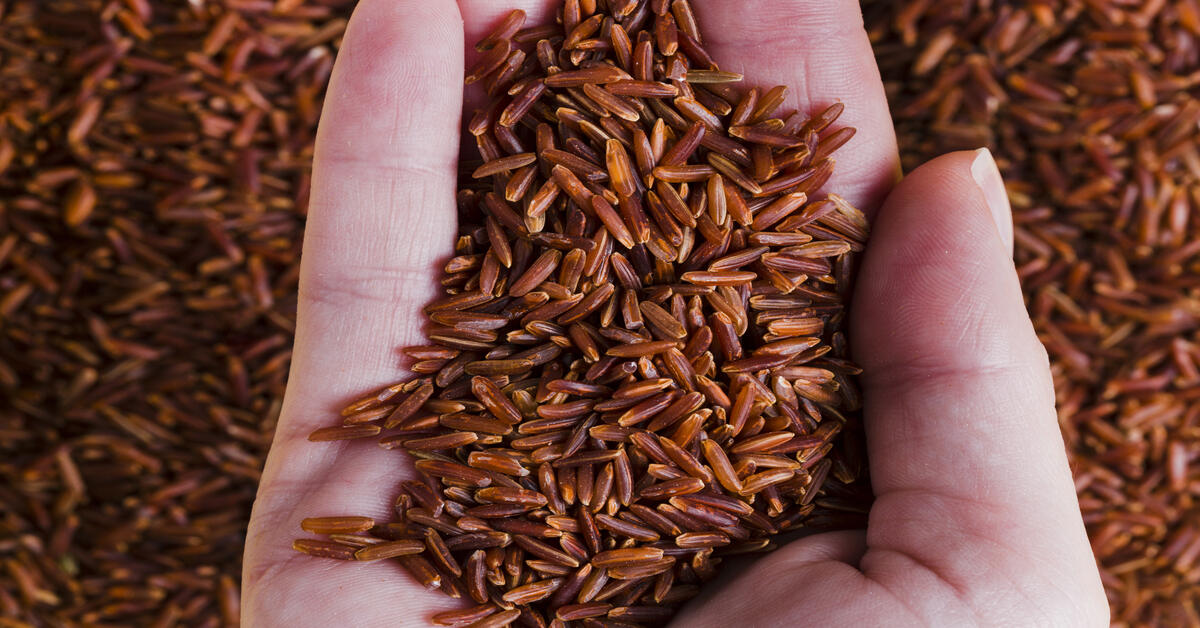Red rice is a wholesome grain with a red color because of its anthocyanin content. People also know it as a laal chawal. It has a rich history and lots of health benefits. It is a fact that people love red rice for its distinctive hue and taste. Red rice has a bunch of advantages in diabetes management, weight management and in other aspects. If you are curious to know more on red rice, then this blog is for you!
Top 10 Red Rice Benefits
Let’s dive deeper into the extensive benefits of red rice, particularly in the context of diabetes, weight loss, and overall health.
Low Glycemic Index (GI)
Red rice contains a lower amount of glycemic index compared to regular white rice. High glycemic index can cause a high and sudden spike of blood sugar. But red rice can give relief to those with diabetes. Its low GI is very advantageous for diabetic patients. It is a favorable choice for those looking to a better option to replace white rice.
Good for Bone Health
Red rice has many benefits. It is a suitable food option even for making the bones healthy. Red rice is a hose of high amounts of phosphorus, magnesium and calcium. All the elements are necessary to make bones stronger. It is a beneficial food option to keep away arthritis and osteoporosis. At the same time, it combats against the low bone density.
Nutrient-Rich
Red Rice is a powerhouse of the essential nutrients that are needed for human health. It contains all kinds of vitamins and minerals. Red rice has essential B vitamins ( B1, B2, B3, and B6) that are needed for metabolism and overall health. Its minerals lis iron and magnesium are also important for playing various bodily functions.
Also Read:- Millets Benefits
Help in controlling diabetes
Red rice has a low glycemic index so it can be consumed by people suffering from diabetes. It helps in maintaining blood sugar levels. Red rice has low glycemic index of around 55 as a result it is digested slowly and glycogen is released slowly in the bloodstream.
Weight Loss Aid
Red rice is considered as a weight management friend. The reason is its high fiber content. Foods with high fiber are meant to keep you fuller for a longer time and keep you away from unhealthy munching. It reduces the calorie count and maintains proper body weight.
Also read : 5 Best Gym in Mumbai
Nutritional Value
The nutritional value of red rice is very impressive! It contains antioxidants and phytonutrients like anthocyanins. All these are beneficial for various health benefits. It helps to reduce inflammation and improves cell health.
Heart Health
Red rice is a good option to maintain your heart health too. It has fiber and antioxidants in good quantities. Fiber helps in lowering the blood cholesterol and antioxidants protect blood vessels. Antioxidants also have a major role in maintaining oxidative stress and inflammation.
Skin Benefits
Red rice not only protects us from the inside, it also makes our skin glowy! The reason is its antioxidants of course. Antioxidants help us to fight against free radicals that can cause premature aging and skin damage.
Helps in Digestion
Yes, red rice is a friendly food option to maintain good digestion. As we have earlier mentioned that it contains a good amount of fiber which helps to add bulk to your stool. It prevents the problem of constipation as well.
Also Read:- Benefits of A2 Cow Ghee
Helps in Breast cancer
Breast cancer has become very prevalent among women these days. Studies have shown that red rice reduces the growth of cancer cells by inhibiting a protein , IL-6 which acts as a main element in the growth of cancer cells. Also red rice stops the spread of cancer cells to other parts and organs of the body.
Comparative Advantage
Red rice holds an advantage over white rice because it retains more of its natural bran layer, which contains valuable nutrients. Red rice has a unique flavor and texture. People find red rice as an interesting food alternative to regular white rice. Yes, it is a fact that red rice has a similar fiber content to brown rice but it offers a distinct taste and appearance.
Red Rice Nutritional Facts
Red rice is small but powerful. It holds ample amounts of nutrients compared to its size. Let’s have a look at its nutrient value.
(Amount per 100 grams)
| Nutritional components | Value per 100 g |
| Energy | 356 kCal |
| Fibre | 11.10 g |
| Protein | 8.89 g |
| Fats | 3.33 g |
| Potassium | 156 mg |
| Sodium | 67.0 mg |
| Zinc | 30.0 mg |
| Iron | 1.11 mg |
Red rice glycemic index
- Red rice has a glycemic index (GI) of 55 and comes in the category of low GI food.
- Red rice has a glycemic load of 38 which makes it a high GL food.
Red Rice Side Effects
Red rice has many perks for our body, still it contains some side effects. Below we have presented some of its possible negative sides.
Gastrointestinal Discomfort
Red rice’s high fiber may not suit a few. They can experience bloating, gas and other digestive issues because of its high fiber. Though it is a minor issue. And if you keep an eye on portion control, it can easily be resolved.
Allergic Reactions
Few people may experience allergic reactions to certain components of red rice. They can have itching, swelling and rashes.
Interference with Medications
If you’re on specific medications, red rice’s impact on blood sugar levels can interfere with the medication’s effectiveness, especially if you have diabetes. Consult your doctor for guidance.
Caloric Intake
While red rice is a nutritious choice, excessive consumption without portion control can lead to increased caloric intake, potentially affecting weight management goals.
It’s essential to be mindful of your body’s response to red rice and consume it in moderation. If you experience any adverse effects, consult a healthcare professional for guidance on your dietary choices.
How to use Red rice
Red rice can be consumed in many different ways. Some of the ways it is generally consumed are listed below:
- Generally In india red rice is simply cooked as plain rice.
- Red rice can be used as salads too by combining it with vegetables, seeds etc.
- Red rice can also be consumed in the form of noodles
- In some south-asian countries red rice is also consumed in the form of porridge.
How to cook Red rice
In a pressure cooker
wash and soak a cup of red rice for 20-25 minutes
Now add this soaked rice in pressure cooker and add around 2-3 cups of water into it. You can also add salt in it
Now cook this red rice for 2 high flame whistles and 2 mild flame whistle
Now once cooked wait for steam to be released. Your red rice is cooked and ready to be served
In a sauce Pan
wash and soak 1-2 cups of red rice for 20-25 minutes
Now add your soaked rice and 3-4 cups of water inside the sauce pan
Start cooking on medium flame and keep stirring it every 5-7 minutes
It will take around 45-50 minutes for the entire cooking process. Once your rice is ready, you can serve it.
Red rice vs brown rice: Which is better
Nutritional content
Both red rice and brown rice are rich in nutrients. But there are some differences between them. Red rice has very high levels of antioxidants and fiber content. It has 10 times more antioxidants content compared to brown rice. On the other hand brown rice has high iron and zinc content.
Glycemic Index
Red rice has lower glycemic index compared to brown rice. Red rice is very suitable for people suffering from diabetes as it helps in effectively managing blood sugar levels.
Cooking Time
Red rice is unpolished and has its outer bran layer which needs little more time to cook. Red rice takes around 50-55 minutes to cook, while on the other hand brown rice takes little lesser time cook. Brown rice gets cooked in about 35-40 minutes.
Conclusion
In conclusion, red rice or laal chawal, is indeed a nutritional powerhouse that offers a range of benefits. It can be a valuable addition to your diet, particularly if you’re aiming to manage diabetes, lose weight, or enhance your skin health. With its lower glycemic index and impressive nutritional value, red rice stands as a healthy alternative. However, as with any food, moderation is key. While red rice has numerous advantages, it’s essential to be aware of your individual dietary needs and consult with a healthcare professional for personalized guidance. Make the most of the health benefits this vibrant grain has to offer while enjoying a diverse and balanced diet.









































